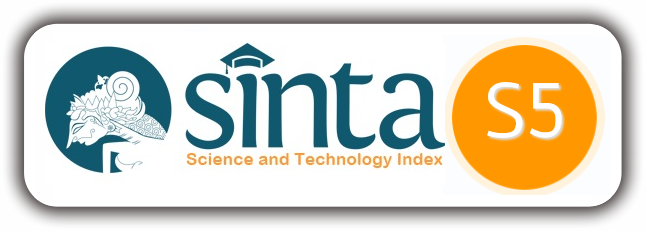Hak Kepemilikan Sisa Jahitan Ditinjau Dari KHES
(1) IAIN Padangsidimpuan
(*) Corresponding Author
Abstract
Sewing is the process of putting together pieces of fabric that have been cut based on a pattern. The sewing technique used must be in accordance with the design and materials, so that the sewing results are good and of good quality. The steps taken in the sewing process are: Prepare the sewing tools needed, such as sewing machines, hand needles, pins, pendedels, and irons. This research is a field research that directly takes data from the research location by using data sources, namely primary data and secondary data. The data collection used in this study is in the form of in-depth interviews (in-dept interviews) directly to tailors and customers. The time to conduct this research is about 2 months and the location of this research is in Hutagodang Muda Village, Siabu District, Mandailing Natal Regency. The subjects of this research are Tailors and their Customers. The results showed that the implementation of the ownership rights for the remaining stitches in Hutagodang Muda Village, Siabu District, Mandailing Natal Regency contained a lack of understanding of the law regarding the remaining stitches between the tailor and the customer, because the tailor did not return the remaining stitches to the customer measuring 1 meter, and this tailor processed the stitches. back the remaining stitches into a stitch, such as shirts, footwear, and hijab brooches, and she took advantage of the remaining stitches. In the Review of the Compilation of Sharia Economic Law on Ownership Rights of Remaining Stitches in Hutagodang Muda Village, Siabu District, Mandailing Natal Regency, where the ownership rights for the remaining stitches, if the customer gives or allows the remaining stitches to be owned by the tailor, the tailor has the right to rework the remaining stitches. that. However, if the customer does not give the remaining stitches to the tailor, then the tailor has no right to reprocess the remaining stitches.
Keywords
Full Text:
PDFReferences
Referensi
a. Sumber Buku
Darmawab & Muhammad Iqbal fasa, Manajemen Lembaga Keuangan Syariah, Yogyakarta: Perguruan Tinggi Indonesia, 2020.
Darmawab & Muhammad Iqbal fasa, Manajemen Lembaga Keuangan Syariah, Yogyakarta: Perguruan Tinggi Indonesia, 2020.
Kompilasi Hukum Ekonomi Syariah.
b. Sumber Jurnal
Ahmad Sainul, “Hak Milik Dalam Hukum Islam,” Jurnal Al Maqasid: Jurnal Ilmu Kesyariahan Dan Keperdataan 6, no. 2, 2020.
Anwar Habibi Siregar, “Analisis Imam Qudamah Tentang Kepemilikan Bahan Galian Tambang Kontinutias,” Jurnal Yurisprudentia, Jurnal Hukum Ekonomi 7, no. 2, 2022.
Dani Amran Hakim, “Perjanjian Lisensi Sebagai Bentuk Pengalihan Hak Kekayaan Intelektual,” Jurnal Yurisprudentia, Jurnal Hukum Ekonomi 7, no. 1 2021.
Dalimunthe, Dermina, “Akibat Hukum Wanprestasi Dalam Perspektif Kitab Undang-Undang Hukum Perdata (BW,” Jurnal Al-Maqasid, Jurnal Ilmu Kesyariahan Dan Keperdataan 3, no. 1 2017.
Gunawan, Hendra, “Tindak Pidana Penipuan DalamPerspektif Fikih Jinayah,” Jurnal El-Qanuniy: Jurnal Ilmu-Ilmu Kesyariahan Dan Pranata Sosial 4, no. 2 2018.
Kurniawan, Puji, “Masyarakat Dan Negara Menurut Al-Farabi,” Jurnal El-Qanuniy: Jurnal Ilmu-Ilmu Kesyariahan Dan Pranata Sosial 4, no. 1 2018.
Mustafid, “Hukum Perbuatan Roasting Dalam Stand Up Comedy Ditinjau Berdasarkan Ketentuan Syari’At Islam,” Jurnal Yurisprudentia, Jurnal Hukum Ekonomi 7, no. 2 2021.
Gunawan, Syafri, “Historis Kajian Hak Azasi Manusia Di Dalam Hukum Islam ....,” Al- Qanuniy: Jurnal Ilmu-Ilmmu Kesyariahan Dan Pranata Sosial 6, no. 2 2020.
DOI: https://doi.org/10.24952/el-thawalib.v3i3.5651
Refbacks
- There are currently no refbacks.









Editorial Office Board :
Kampus UIN Syekh Ali Hasan Ahmad Addary Padangsidimpuan
Jl. T Rizal Nurdin No.Km 4, RW.5, Sihitang, Padangsidimpuan Tenggara, Kota Padang Sidempuan, Sumatera Utara 22733
 Jurnal El-Thawalib is licensed under a Creative Commons Attribution-ShareAlike 4.0 International License.
Jurnal El-Thawalib is licensed under a Creative Commons Attribution-ShareAlike 4.0 International License.
View My Stats






